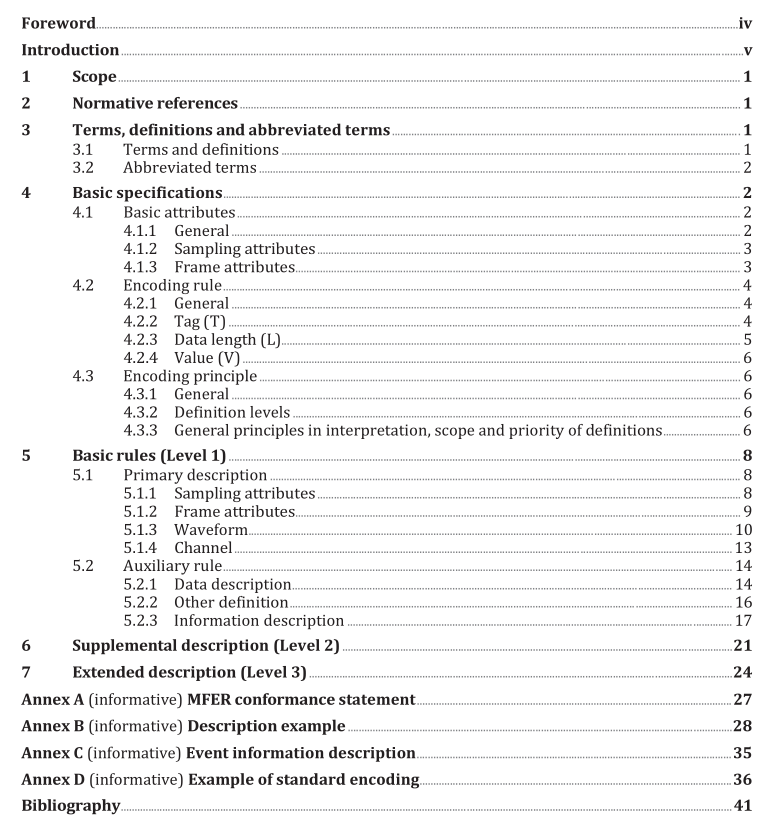ISO 22077-1 pdf download

ISO 22077-1 pdf download Health informatics — Medical waveform format — Part 1: Encoding rules
4.2.3.5When the data length is o
“Data length O” indicates that the definition indicated by tag resets to the default value.Namely,on theroot definition, the concerned items re-initialize to default values, and in cases of the channel definition,the channel definition is re-initialized to the root definition.
4.2.4Value (v)
The header or waveform data values are encoded in the value section according to descriptors specifiedby the tag.
4.3Encoding principle
4.3.1 General
All definitions in MFER have default values, so any additional or amended definitions are optional.Thus, the definition corresponding to each tag has a default value, so re-definition is not necessary ifthe default value is retained. lt is expected that default definitions will suffice for most purposes.
4.3.2 Definition levels
4.3.2.1 Level1 — Basic definitions
Definitions at level 1 are basic definitions,which are ordinary rules (marked with an asterisk) andensure precise encoding.
4.3.2.2 Level2 – Supplementary definitions
Definitions at level 2 are supplementary definitions.They may be used as required but it is desirable toassociate the supplementary definitions with a host protocol where they can be defined with the hostprotocol.
4.3.2.3 Level 3— Extended definitions
Definitions at level 3 are extended definitions, which should be used as little as possible. Iltems of theseextended definitions can considerably affect the system with regard to security.Thus, great care shouldbe taken when using them.
4.3.3 General principles in interpretation, scope and priority of definitions4.3.3.1 Initial values(default value)
All definitions in MFER have initial values that are applied until redefined by any subsequent definition.
4.3.3.2 Multiple definitions Multiple definitions may be made for any item. Depending on the items, a new definition, an old definition or all definitions (such as for events) can be used multiple times. For example, setting the sampling frequency to 250 Hz overrides the initial value of 1 kHz. If multiple events occur, they are interpreted in definition order.
4.3.3.3 Later definition priority Each definition is interpreted in definition order. If an item has related definitions, definition should be made in due order. The default endianity is big-endian, so to use little-endian endianity the definition for little-endian must be designated. For example, before defining each channel, the number of channels should be defined.
4.3.3.4 Channel attributes definition order Before defining the attributes of a channel, the number of channels should be defined. If the number of channels is defined later, previous channel definitions are reset to the root definition including default values.
4.3.3.5 Root definition (general definition) and channel definition (definition per channel) The root definition is effective for all channels. The channel definition is effective only for the relevant channel and overrides the root definition. However, care should be taken because if a subsequent change to the root definition is made it will override the default content of the relevant channel for subsequent channel definitions. For example, if EEG is designated in the root definition, ECG designated for a channel in the channel definition overrides EEG.
4.3.3.6 Definition reset If the data length is defined as zero (no data) in the definition of an item, the content in the definition is reset to default value. If the data length is designated as zero in a channel definition, the definition follows the root definition including the default value. If the number of channels is defined, contents defined for the channel attribute are all reset to the root definition including the default value.
4.3.3.7 Incomplete definition ignored If a definition is made without an adequate preceding definition, the definition is ignored. In the absence of any complete definition, the default root definition will be applied. For example, if the number of channels is undefined, any dependent channel definition is ignored.
4.3.3.8 Succession of definitions Unless redefined, each definition applies to all succeeding frames in the effective range, except for the data pointer which is succeeding renewed. Thus, contents defined in the root definition apply to all frames unless overridden by channel definition(s), so it suffices to define common items in the root definition. For example, to use little-endian for all encodings with MFER, define little-endian once, then it is effective over the whole region irrespective of frames.









